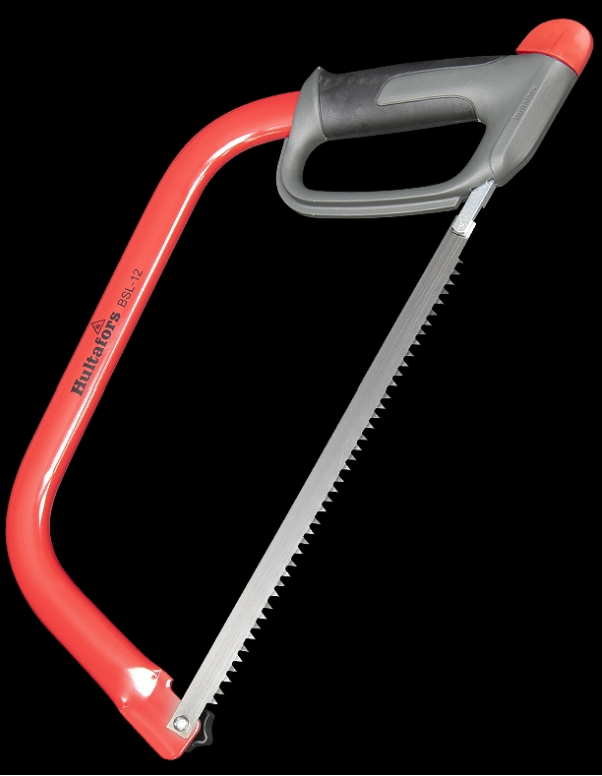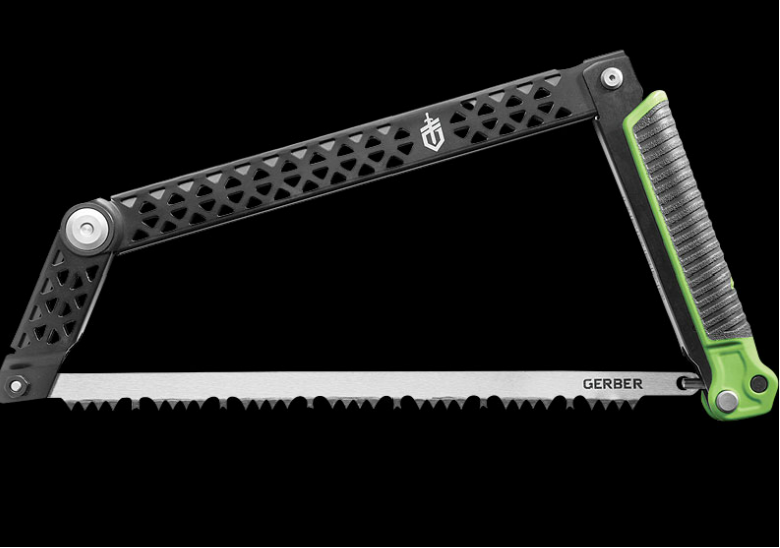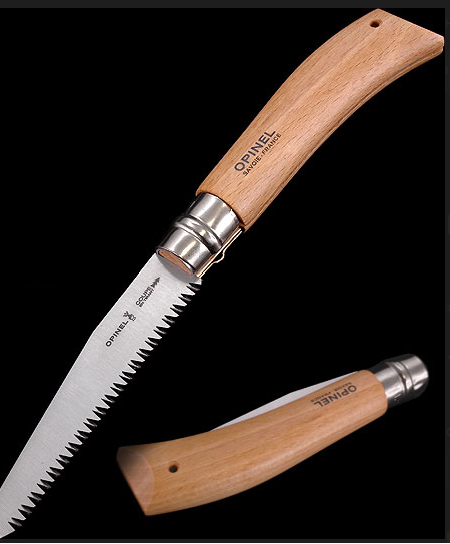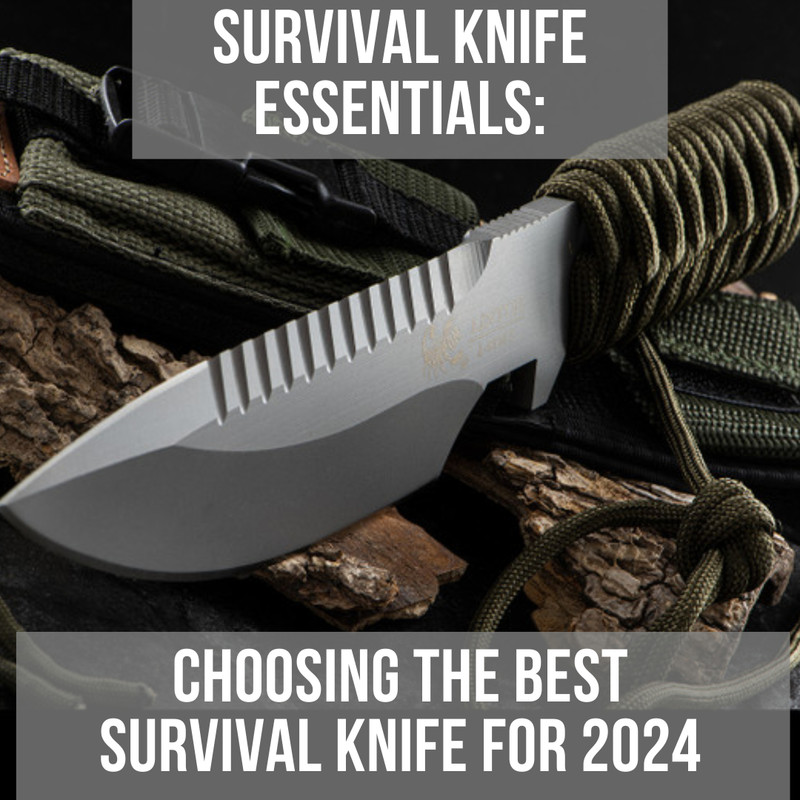Survival Saws: Your Guide to the Best for Outdoor Use
Posted by HH on 5th Oct 2023
Have you ever found yourself in a woodland, feeling like an insignificant speck compared to the lofty trees and surrounded by a deafening quiet? In such situations, survival saws can become your best mate.
This isn't just about cutting wood for a fire or clearing a path. It's more than that - it’s about turning what could be a dire survival situation into something manageable, even comfortable.
Here, we're going deeper – revealing secrets behind teeth patterns and handle comfort which could turn any survival product into an outdoor must-have!
If this has aroused your curiosity, then stay tuned!
Table Of Contents
- Understanding Survival Saws
- Exploring Different Types of Survival Saws
- Key Features in a Survival Saw
- The Best Survival Saws on the Market
- How to Use Your Survival Saw in Wilderness Scenarios
- Cutting Firewood Efficiently
- Making Larger Cuts Safely
- Felling Trees Responsibly
- Tackling Tough Materials with Ease
- Using Your Saw Creatively
- Caring for Your Survival Saw
- Cleaning and Lubricating Your Saw
- Sharpening for Optimal Performance
- Choosing the Right Survival Saw for You
- Type of Blade Material
- Saw Size and Portability
- Cutting Efficiency
- Tips for Effective Use of Survival Saws
- Making Quick Work with Your Saw
- Finding Comfort While Cutting
- Leveraging Longer Blades for Larger Cuts
- Maintaining Your Saw
Understanding Survival Saws
When it comes to surviving in the wilderness, a reliable survival saw can be your best friend. Selecting the correct implement isn't just about sawing logs or removing dead wood; there's more to it than what initially meets the eye.
Exploring Different Types of Survival Saws
Different situations call for different tools. For instance, pocket chainsaws are great if you need something lightweight and compact but powerful enough to cut through branches and small logs with ease.
Folding saws, on the other hand, offer versatility and convenience. They're easy to carry around due to their foldable design, yet robust enough for larger tasks that require serious wood-cutting power.
Bow saws come into play when dealing with heavier workloads like large trees or thick branches - they have longer blades capable of making quick work out of these tough tasks.
Silky saws are compact, lightweight, and highly efficient hand saws that are designed for outdoor enthusiasts, campers, hikers, and survivalists.
Key Features in a Survival Saw
The blade is arguably one of the most critical aspects of any survival saw. High carbon steel blades are favoured by many outdoor enthusiasts because they’re durable and maintain sharpness over extended use periods.
The length and tooth pattern also play crucial roles depending on what you intend to cut – whether it’s fine carving work or heavy-duty log splitting, each task requires specific features for optimal performance.
But let's not forget about handle comfort too. A good grip can make all the difference during long term usage – think rubber handles which provide both cushioning and excellent hold even in wet conditions.
In short: The type of survival saw you choose can make or break your wilderness experience. From pocket chainsaws to folding and bow saws, there's a tool for every task out there - so do yourself a favour and get acquainted with the different types of survival saws today.
Key Takeaway:
Survival saws are vital wilderness companions, offering more than just firewood cutting. From compact pocket chainsaws to versatile folding saws and powerful bow saws, there's a tool for every scenario. High carbon steel blades offer durability while the length and tooth pattern tailor to specific tasks. And don't forget comfort - a good grip is essential.
Could Your Survival Kit Benefit From a Silky Saw?
When it comes to survival kits, most of us think of the basics: food, water, shelter, and first aid supplies. But what if we told you that there's a tool that could make life in the wild a whole lot easier?
Enter the silky saw, a nifty piece of gear that might just be the missing link in your survival kit.
What Is A Silky Saw?
A silky saw isn't your typical saw. It's not big, heavy, and clunky like the one you might have in your garage. Instead, it's a compact, lightweight, and highly efficient hand saw that's designed for outdoor enthusiasts, campers, hikers, and yes, survivalists.
These saws are of Japanese origin, where they are renowned for their precision craftsmanship.
How Can You Use A Silky Saw?
Now that you know what a silky saw is, let's talk about why it deserves a place in your survival kit.
- Cutting Wood: One of the primary uses of a silky saw is cutting wood. Whether you need to build a shelter, start a fire, or fashion tools and weapons, a silky saw can make the process much easier. Its sharp teeth and ergonomic design allow for efficient and controlled cutting through branches and logs.
- Pruning and Clearing: In a survival situation, you may need to clear a path, create traps, or remove obstacles from your campsite. A silky saw is perfect for this job, as its compact size makes it easy to manoeuvre in tight spaces, and its sharp teeth excel at cutting through vegetation.
- Food Preparation: Hunting and fishing are common activities in survival situations. A silky saw can help you process game or fish by easily and cleanly cutting through bones and joints. It can also be handy for slicing and dicing edible plants and roots.
- Tool Maintenance: Keeping your other tools in good working condition is crucial for survival. A silky saw can help you sharpen blades, create notches in wood for various purposes, and even fashion replacement parts.
Why You Need a Silky Saw in Your Survival Kit
Survival kits need to be lightweight and compact, and a silky saw fits this perfectly. Its small size won't weigh you down, making it an ideal addition to your kit. Furthermore, traditional saws can be slow and tiring to use.
The silky saw's razor-sharp teeth and efficient cutting action get the job done quickly, conserving your energy for other survival tasks. These saws are built to last. They are made from high-quality materials and are resistant to rust and corrosion, ensuring they'll be ready for action when you need them most.
Finally, the silky saw's ability to cut through wood, bone, and vegetation makes it a versatile tool for a wide range of survival scenarios. It's like the Swiss Army knife of saws!
A silky saw is a valuable addition to any survival kit. Its compact size, efficiency, durability, and versatility make it a game-changer in the wild.
The Best Survival Saws on the Market
When it comes to survival gear, a top-notch saw can be your best mate. No matter if you're preparing for a lengthy hunting journey or simply require some assistance with garden work, possessing a dependable tool close by is crucial.
Here are a few of our favourite picks:

BCB Commando Wire Saw - The original commando saw - packs down to a micro size, and really makes short work of most tasks.

Hultafors Compact Bow Saw BSL-12 - A long-term bestseller. Superbly engineered, with high quality replaceable blades in a compact size.

Gerber Freescape Camp Saw - A folding saw with big ideas - this can be easily packed, but deployed in a trice when there’s firewood to treat.

Opinel Folding Saw No.12 - A classic of the genre - Opinel’s folding saw is a work of art - well engineered, and pocketable.
How to Use Your Survival Saw in Wilderness Scenarios
A survival saw is a key component of any serious outdoor enthusiast's kit. Knowing how to operate a survival saw proficiently is not the same as having one.
Cutting Firewood Efficiently
To make quick work of cutting firewood, select your tree carefully. A fallen tree or dead standing wood makes an excellent choice because it’s drier and easier to burn than green wood.
Position yourself correctly: plant your feet firmly on the ground about shoulder-width apart for balance. Make sure you're clear from overhangs or other obstacles that might interfere with your sawing motion.
Making Larger Cuts Safely
Safety should always be paramount when using a tool as aggressive as a high carbon steel blade pocket chainsaw. For larger cuts, start by making a notch on the side where you want the cut to fall - this helps guide the cut direction safely away from you.
Felling Trees Responsibly
If there's no option but to fell a live tree (only in real survival situations), remember that responsibility doesn't end once it's downed. Clear debris and trim branches promptly so they don't pose risks for others moving through after you've left.
Tackling Tough Materials with Ease
The tooth pattern on some saws makes them great for cutting through tough materials like bone or even some metals. But remember, it's important to have a replacement blade handy as these tasks can quickly dull your saw.
Using Your Saw Creatively
A survival situation might require you to think outside the box with your tools. Don't be afraid to use your survival saw creatively - whether that's fashioning makeshift shelter poles from branches or creating traps and snares from wood.
Remember, practice makes perfect. So get out there and put these tips into action.
Key Takeaway:
Master your survival saw: select dry wood for efficient firewood cutting, make safety notches for larger cuts, and fell trees responsibly. Your saw can tackle tough materials like bone or metal – just keep a spare blade ready. Don't shy away from creative uses in survival scenarios.
Caring for Your Survival Saw
Like any tool, survival saws need a bit of TLC to keep them in tip-top shape. But don't fret. It's not rocket science. Let's delve into the details of preserving your life-saving tool.
Cleaning and Lubricating Your Saw
First things first, cleanliness is next to godliness when it comes to survival gear maintenance.Use a soft brush or cloth to wipe off dirt from your blade after use. Remember that water can be an enemy too if left unchecked on blades - especially those made from high carbon steel.
Once cleaned, make sure you dry your saw thoroughly before storing it away. The secret sauce? A dab of oil on the blade will help prevent rusting and ensure smooth cutting action during your next outdoor adventure.
Sharpening for Optimal Performance
A dull blade is as useful as a chocolate teapot in a survival situation - not very. Keep yours sharp with regular sharpening using a diamond file or stone suited for cutting edge maintenance.
Bear in mind though; every saw has its own unique tooth pattern which may require different techniques while sharpening. So always check out manufacturer guidelines first.
You'll also want replacement parts handy just in case something goes awry during yard work or hunting trips (we've all been there.). Keeping extra blades available ensures you won't be left high and dry in the wilderness.
So, whether you're a seasoned survivalist or a newbie exploring the world of folding saws, these simple tips will help keep your trusty tool in fighting fit condition. Because when it comes to survival situations - you don't want to bring a blunt knife to a tree fight.
Key Takeaway:
Maintaining your survival saw isn't hard. Clean and lubricate it regularly to prevent rust, sharpen the blade for optimal performance, and keep replacement parts handy in case of breakages. Whether you're a pro or a newbie, these tips will ensure your tool stays sharp - literally.
Choosing the Right Survival Saw for You
Selecting the right survival saw hinges on your specific needs and anticipated survival scenarios. Seems like a challenge, but let's simplify it.
The first thing to consider is the type of saw. Folding saws are quick to assemble and more portable than bow saws, making them ideal if you're planning a long hike or a camping trip where weight matters. However, only carrying a blade can reduce weight even further, but keep in mind that this may decrease efficiency.
Your choice also depends heavily on what tasks you'll be using your survival saw for. Will you need it for yard work at home? Or perhaps cutting firewood while out camping? Maybe even clear debris during an emergency situation?
Type of Blade Material
A high-quality steel blade like carbon steel or stainless steel should be top priority when choosing your tool as they are sturdy enough to withstand tough conditions over time. High carbon steel blades tend to hold their edge longer than other types; however, they can rust easily without proper care.
Saw Size and Portability
You want something compact folding yet durable if portability is crucial for you, a model that folds flat makes transporting them a breeze. And don't forget about handle comfort too - having rubber grips or similar options ensures maximum control over cuts.
Cutting Efficiency
If fast cutting action appeals more then go with aggressive tooth patterned models.
To sum up: think carefully about how often you will use it, what kind of material will cut most frequently (softwoods vs hardwoods), ease transportation versus functionality ratio plus don't forget about the durability aspect.
Choosing the right survival saw isn’t just a purchase – it’s an investment in your safety and preparedness. So, take time to research before making that crucial decision.
Key Takeaway:
Choosing the right survival saw depends on your specific needs, tasks and portability requirements. Consider factors like blade type, with high-quality steel being a sturdy choice, and handle comfort for control over cuts. If fast cutting is key, choose models with aggressive tooth patterns. Remember it's not just a purchase – it’s an investment in safety.
Tips for Effective Use of Survival Saws
But knowing how to use it effectively is crucial.
Making Quick Work with Your Saw
The secret to making quick work with your saw lies in the tooth pattern and sharpness of its blade. High carbon steel blades offer high quality cutting action. Too much pressure could cause excessive wear and tear, even if you possess a powerful blade.
Whether you're dealing with yard work or handling a survival situation, let gravity do most of the hard work by holding your saw at an angle while cutting wood.
Finding Comfort While Cutting
A comfortable handle makes all the difference when using folding saws over long periods. The rubber grip on some models offer enhanced handle comfort that prevents blisters during extended usage sessions.
If possible, alternate hands periodically during heavy-duty tasks to prevent fatigue from setting in one arm more than another. Here's a handy guide to get started right away.
Leveraging Longer Blades for Larger Cuts
Sometimes size does matter. When dealing with larger cuts such as tree trunks or thick branches; longer blades prove their worth. To ensure smooth operation remember not to force through but allow the tooth blade’s design to cut large sections effortlessly – just remember: slow and steady wins the race.
Maintaining Your Saw
Proper care of your survival saw can prolong its lifespan. This involves cleaning it after use, lubricating moving parts if needed, and storing it in a carrying case to protect against dust or moisture.
In addition to regular maintenance, knowing when and how to replace blades is crucial. For example, a replacement blade for Bahco Laplander can be easily purchased here.
Key Takeaway:
When it comes to survival saws, they can be a real lifesaver in the wild. But, you've got to know how to use them right. The trick? Let gravity and your blade's design carry most of the load while keeping heavy pressure at bay. Don't forget about comfort - go for models with cosy handles and don't shy away from switching hands when tasks get tough. And if you're tackling bigger cuts, that's where longer blades really shine.
So, survival saws. They're more than just a tool; they're your wilderness companion. You've discovered how versatile they can be.
You’ve learnt that handle comfort and blade material are key factors when choosing a saw. You know now which models stand out in terms of quality and reliability.
We delved into their usage too – clearing debris or preparing firewood is no longer a daunting task for you. And with proper maintenance tips under your belt, you’re ready to make sure these tools last long term.
In short, whatever wilderness throws at you next time around, remember this: With knowledge about survival saws on hand, you have what it takes to tackle it head-on!







